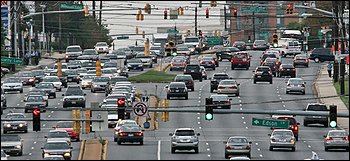Montgomery County redefined the way it will grow in the next two decades when lawmakers endorsed a plan Tuesday that encourages development where residents can easily live a car-free lifestyle.
The County Council, after weeks of intense debate over the county’s growth policy, unanimously agreed to give developers discounts to build dense developments near transit stations as long as they also construct bike paths and walkways, put shops and other amenities nearby, and use environmentally friendly construction methods.
I don’t do a lot of local area reporting, but this front page (!) Washington Post story, “Montgomery draws a car-free blueprint for growth,” seemed newsworthy. The picture above is of the Rockville Pike corridor, and anyone who has driven around Rockville knows it is as car-centric as anywhere in America.
The county is working to change that:
Most suburban growth plans — including Montgomery’s, until Tuesday — discourage development in congested areas, including those near public transit, and encourage construction in more sparsely populated communities, on the theory that new developments should arise where traffic is still tolerable.
But Montgomery’s new plan takes a different tack, one that smart-growth advocates say is long overdue. With the population nearing 1 million, the Washington suburb is substantially larger than the big city to its south but is still managing growth as if everyone can hop in a car and quickly get where they want to go.
The county’s growth policy is revisited every two years. The new plan could boost efforts to redevelop the jumbled White Flint area along Rockville Pike and provide new impetus to build a “science city” spearheaded by Johns Hopkins University west of Interstate 270 near Gaithersburg….
The council also endorsed a plan from County Council member Roger Berliner (D-Potomac-Bethesda), whose district is likely to be the epicenter of much of the urban-style growth, to use development fees to improve a transit system that commuters say is increasingly inadequate….
Planners predict that 200,000 people are likely to move to the county in the next 20 years, bumping the population to more than 1 million. To find a way to house the expected newcomers and get them to and from work, the Planning Board had recommended that developers get discounts and rewards if they are willing to idle their properties for a few years and to build denser development and taller buildings, up to 300 feet in some areas, near the county’s Metro stations.
The Planning Board has also tried to make improving transit an ironclad condition of much new development.
When the board approved the proposed science city in July, members were adamant that it could not be built unless the proposed Corridor Cities Transitway bus or rail system is funded and built. Funding transit, however, is up to federal, state and local lawmakers, all of whom are struggling with massive budget shortfalls, so the Planning Board can advocate for but not create it.
As the price of oil returns to and then exceeds its previous records, funding for bus or rail systems will become a bigger and bigger priority state and federal level, so it is important for local planners to start designing for that.
And while I’m not certain the phrase “car-free” is a fully accurate description of what Montgomery County is pursuing, they deserve kudos for this smart growth plan.
Related Post:


